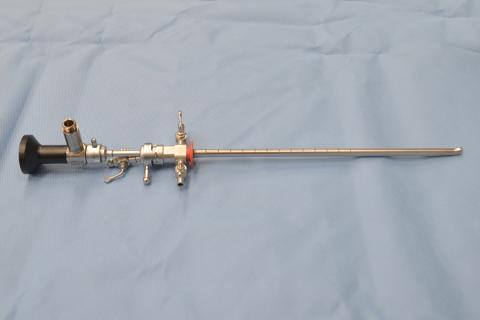A cystoscopy is a procedure during which the inside lining of the bladder and urethra are inspected using a special telescope called a “cystoscope”.
The cystoscope is passed into the bladder via the urethra (or water pipe).
Cystoscopy gives information regarding the structure of the urethra, prostate (in men) and bladder. It is used to look for abnormalities in the lower urinary tract including:
- In the urethra e.g. urethral stricture or scarring
- Prostate – assessment of size and blockage
- Bladder – to look
- Bladder cancer
- Bladder stone
- Other abnormalities of the bladder lining caused by
It is, however, important to realise that most people with urinary incontinence or bothersome urinary symptoms do not need to have a cystoscopy.
In the majority of people, the history, physical examination and basic investigations are enough to make the diagnosis of the type of incontinence and start treatment.
What is the difference between a Flexible Cystoscopy and a Rigid Cystoscopy?
There are 2 types of cystoscopy – flexible cystoscopy, or rigid cystoscopy.
Flexible cystoscopy
Flexible cystoscopy uses a fine flexible telescope and can be performed under local anaesthesia (using local anaesthetic gel inserted into the urethra) while the patient is wide awake. Patients can therefore drive themselves home.
Flexible cystoscopy can also be performed in hospital with sedation. This type of procedure can be performed in Dr. McKertich’s rooms (under local anaesthesia only) as well as in hospital.

Flexible cystoscopy has the advantage of greater patient comfort and ease of procedure without the need for sedation.
A disadvantage of a flexible cystoscopy is the inability to take significant biopsies of the bladder and treat abnormalities within the bladder at the same time (which can be performed during a rigid cystoscopy). Sometimes a rigid cystoscopy may need to be performed at a later date after a flexible cystoscopy if a significant abnormality is detected in the bladder.
A flexible cystoscopy can also be performed at the same time as urodynamic study.
Rigid cystoscopy
Rigid cystoscopy uses a larger telescope passed through the urethra (or water pipe) through which biopsies can be taken and bladder abnormalities treated. The larger instruments and different angled telescopes used at rigid cystoscopy can provide improved visibility and better optics. Due to the larger size of the cystoscope used, the procedure needs to be performed under general anaesthesia or sedation in hospital as a day procedure.

Rigid cystoscopy can be combined with other procedures such as resection of bladder tumours, removal of stones, removal of stents or prostate surgery.
Who needs a Cystoscopy?
Some of the reasons people need a cystoscopy include:
- Blood in the urine (or haematuria)
- Recurrent urinary tract infections
- Abnormal cells in the urine found on laboratory testing
- Bladder pain and irritative voiding symptoms
- Blockage symptoms
- Previous surgery on the bladder or urethra (e.g. to treat incontinence)
- Bladder abnormalities seen on imaging studies
- Incontinence
- Painful bladder conditions
- Patients with a history of TCC (transitional cell carcinoma of the bladder)
What happens during flexible cystoscopy?
- The test is performed with the patient awake while lying down and the procedure takes about 15 minutes to complete.
- Local anaesthetic gel is placed via a syringe into the urethra (waterpipe) to make the insertion of the flexible cystoscope more comfortable.
- The flexible cystoscope is passed into the urethra after the area is washed with a sterile antiseptic solution.
- The urethra and bladder are gently filled with a sterile saline solution to allow the area to be closely inspected. This may result in a mild feeling of urgency and bladder discomfort which are relieved on removal of the cystoscope and after passing urine.
- At the end of the test, the patient passes urine and can go home immediately and drive without any restriction in activity.
- Results of the cystoscopy are discussed on the spot and further treatments (e.g. with medication) can be started immediately after the test.
Will it be uncomfortable?
Local anaesthetic gel is used to help numb the area before inserting the tubes but there may be some mild discomfort. A mild burning sensation can occur after the test or a trace of blood in the urine. These symptoms settle with increase fluid intake and use of Ural® sachets.
Most people find that the test is not as unpleasant as the chronic bladder problems with which they have been living.
What information is gained from a Cystoscopy?
Cystoscopy provides information about the anatomy and structure of the lower urinary tract i.e. the urethra, prostate (in men) and bladder lining.
A urodynamic study provides information about the function of the bladder and urethra, and may be combined with a flexible cystoscopy (that gives anatomical information).





